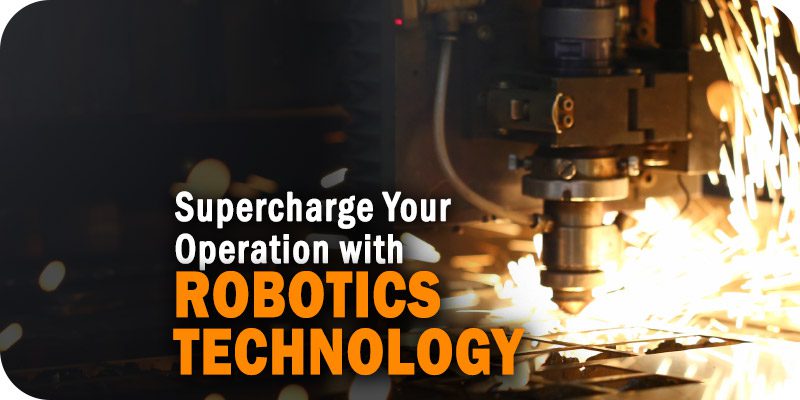Supercharge Your Factory Operations with Robotics Technology


As part of Solutions Review’s Contributed Content Series—a collection of articles written by industry thought leaders in maturing software categories—Rick Veague, the Chief Technical Officer at IFS, examines how ERP-powered robotics technology helped a North American manufacturer boost savings and productivity.
In a manufacturing landscape burdened with labor shortages and rising costs, keeping pace with customer demand and expectations is no easy feat. Here to help make a difference are ERP-powered robots, which take the form of ground-level machines capable of performing recurring tasks with more accuracy and at a quicker pace than humans. These robots might not be glamorous pieces of equipment that complete intricate assembly tasks or perform life-saving procedures. However, make no mistake; they carry their weight—a hefty $1.5 million in savings per year.
For example, by integrating six ERP-driven robots into its company processes, Cheer Pack, a North American manufacturer of spouted packaging, transformed its manufacturing operations. In this article, we’ll delve into how robotics technology helped Cheer Pack boost its annual savings, reduce costs, and encourage productivity throughout its workforce.
Robotics Technology in Manufacturing
In today’s manufacturing landscape, concerns over skills, expertise, and the number of workers available have all impacted how organizations operate. According to Alex Ivkovic, the Chief Information Officer at Cheer Pack, “Labor shortages have been a pertinent issue for Cheer Pack even before the pandemic and recent skills shortage. Alongside many other manufacturers, we looked to alternative methods to fill the human void.”
This led to the introduction of industrial robotics—machines adept at inspecting, assembling, and packaging products within a factory or warehouse. This frees workers to focus on other areas of operations. A recent PwC report found that over a third of U.S. manufacturing organizations plan to prioritize robotics and warehouse automation over the next two years.
Down on the ground—literally!
At Cheer Pack, the company designed a robotics strategy introducing a team of six efficient and self-charging robots moving critical materials around its ground-level warehouse operations. These floor-level robots take instruction from the Cheer Pack ERP (Enterprise Resource Planning) system to shuffle around the warehouse and ensure critical materials are available where and when required on the manufacturing line. These bots might be small, but they deliver—the company has unlocked $1.5 million in savings per year thanks to its ERP and robotics integration.
Ultimately, Robotic Process Automation (RPA) is about mitigating latency from the manufacturing process, whether it be guaranteeing the right parts or materials are available or assigning tasks to best unlock the skills and expertise of operators. Combined, all these elements will help organizations exceed consumer expectations and deliver on critical service moments.
Disrupting the robotics “norm” with ERP-powered software
Using robotics in the manufacturing sector is not an entirely new phenomenon. For example, consider robotic welding, commonly used in the automotive industry or material handling applications. However, for many manufacturers, automated robots are a brand-new concept, and misconceptions surrounding robots have often acted as a deterrent.
Robots are renowned for operating in real-time and on the manufacturing line. On the other hand, ERP systems take a backseat approach and work behind the scenes on distributing and scheduling the robots. The heritage of ERP is process orchestration, and although critical for high-scale business operations, these systems can be enhanced by robotics and vice versa. RPA is already fulfilling a similar role with the automation of intelligent business workflows. In contrast, robots are responsible for the automation of intelligent actions. Both must be orchestrated to work together to achieve the desired result (i.e., entering the correct product number, order number, or materials required).
Pertinent labor issues encourage robotics integration
Before integrating robotics technology, labor had been a significant challenge for Cheer Pack. The story is no different for many other industries worldwide; now, the market has propelled into a candidate-driven landscape. Research from the U.S. Bureau of Labor Statistics has shown that as of March 2022, the number of job openings in the U.S. was 11.5 million. It’s no surprise, then, that countless manufacturing organizations are searching for technology that can fill gaps in human labor and keep pace with growing market pressures.
Despite already employing an ERP system, Cheer Pack recognized there was potential to add more value to its robotic strategy to carry out warehouse procedures. “Integrating six robots with Cheer Pack’s ERP solution took approximately two months, where just a few challenges over Wi-Fi connectivity and aisle widths became evident. As a result, Cheer Pack was driven to upgrade its existing Wi-Fi system, particularly at low-height levels, and adjusted aisle widths to enable the safe maneuvering of vehicles,” Ivkovic said.
Robots overtaking humans? The answer is in the stats.
For many years, people have believed in the ethos that robots will replace human activity and be responsible for many workers losing their jobs. Cheer Pack is a prime example of how this is not the case. They are designed to work alongside humans by helping with monotonous and repetitive tasks, ultimately streamlining operations. “Since implementing robots a few years ago, Cheer Pack has been able to redistribute staff into other areas of the business and help find more fulfilling jobs for them to complete. In fact, not one staff member at Cheer Pack has lost their job because of robotic installation,” explained Ivkovic.
The benefits are clear to see. Robotics can drive efficiencies while reducing costs, proven by Cheer Pack realizing annual savings of $1.5 million per year. The robots require zero human entry or interaction, meaning shop orders are sent directly to the ERP system, leaving no room for human mistakes. This improves compliance, processing times, and the overall customer experience offering. Robots can work around the clock without getting tired, automatically reducing the risk of error. Cheer Pack’s robots can even take themselves back to a charging bay when they need a break, while another is readily available to operate in its place!
Robots + AI: The perfect pair for improved predictions
Already, robotics technology is changing the way manufacturers operate. But as technology evolves, so will robotics, which will inevitably become a “must have” for manufacturing organizations looking to keep up with staff shortages, customer expectations, and competition. Like IoT (Internet of Things), the next stage for robotics will encompass artificial intelligence (AI), where predictive analytics can help improve the flow of robotic operations and give manufacturers clearer visibility.
As more organizations look to robotics as part of their future operations, the forward-thinking companies will pair them with ERP systems that realize the most value. ERP orchestration will help businesses experience benefits at scale depending on their respective industries and use cases, from alleviated costs to reduced human labor issues.























